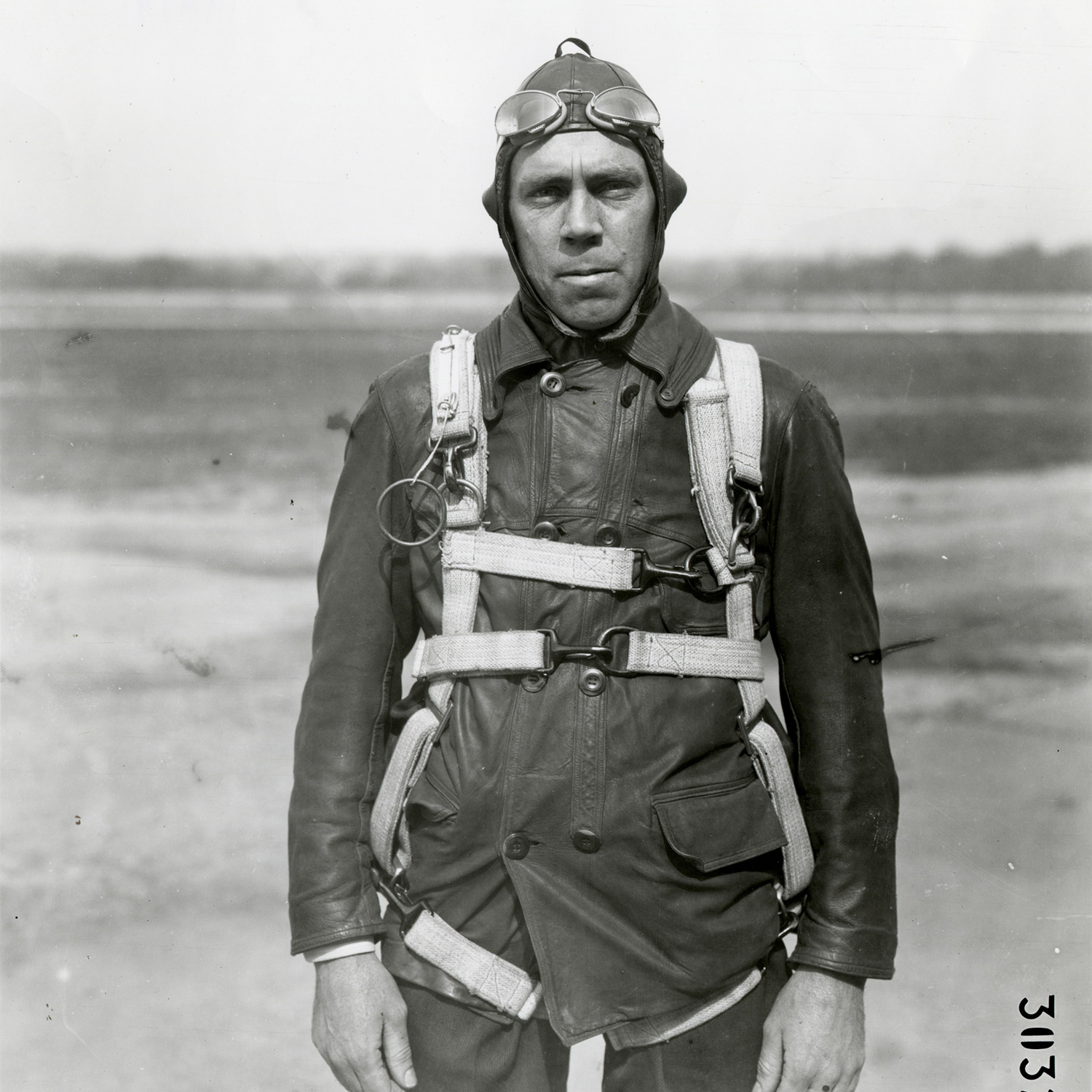
Pulling the rip cord
At the end of World War I, parachutes still weren’t standard equipment for military pilots. To address concerns about their use, Floyd Smith, a pilot himself, designed the first parachute that incorporated a manually operated rip cord. It changed the world of aviation and saved countless lives, and Smith’s innovative spirit continues to set an example for daring inventors and entrepreneurs.
For his contributions to aviation and safety, Smith was posthumously inducted into the National Inventors Hall of Fame in 2022.
10 min read
Each month, our Journeys of Innovation series tells the stories of inventors or entrepreneurs whose groundbreaking innovations have made a positive difference in the world. This month, Marie Ladino's story focuses on test pilot and inventor Floyd Smith, who created the first modern operational parachute. To read about other historical inventors or National Inventors Hall of Fame inductees, visit innovators of the past or Greatest in innovation.
Visitors to USPTO headquarters in Alexandria, Virginia, can now explore special exhibits about Smith and his parachute, including an interactive parachute jump experience located in the agency's 10-story atrium.
On a windy day in April 1914, Floyd Smith’s wife Hilder climbed out of a biplane 650 feet above the Pacific Ocean, just beyond the new Los Angeles Inner Harbor. A cord tethered the parachute in her backpack to the plane and would release the pack’s restraining straps when she jumped. Surprised when she looked down and saw the ocean, Hilder panicked. She wasn’t a swimmer, and she didn’t realize the pilot had flown beyond the harbor to compensate for the drift she would experience on her way down. Hilder reached back to grab the cockpit rail but was unable to hold on. She fell from the plane in a fast spin that twisted the lines of the parachute as her weight pulled them from the pack, preventing the canopy from opening properly. Plummeting toward the ocean, Hilder managed to dislodge the canopy and remove the vent from the top. The canopy filled with air and opened about 250 feet above the water. As Hilder described it, “I … had to lift my feet to clear the masts of the navy boats but managed to reach land, missing the water by 50 feet.” This terrifying experience, along with a pressing need to protect fellow pilots, led Floyd Smith to develop a parachute the jumper could operate manually, at a safe distance from the plane.
James Floyd Smith, known to most as Floyd, was born in Geneseo, Illinois, in 1884. As a young man, he moved to California, where he worked as a trapeze artist in a circus troupe called the Flying Sylvesters. He soon met Hilder, who joined the act when she married Floyd.
After spending five years in the circus, the Smiths decided to pursue a new passion—aviation. They had saved some money, which they put toward aeronautical studies and the construction of their own plane in 1912—just nine years after the Wright Brothers’ first successful flight at Kitty Hawk, North Carolina. As Hilder explained, “In those days, if you wanted to fly, you either bought a plane or built one and flew if you could and it would.” Floyd quickly took to flying. Influenced by their circus experience, the couple got involved in “barnstorming,” or traveling around the country performing aerial stunts above crowds of excited observers.
A few years later, the Smiths returned to California, and Floyd took a job as a test pilot for the renowned airplane designer and manufacturer Glenn L. Martin. In 1915, he established new altitude records in flights over San Diego, and two years later, he made the first simulated aircraft carrier landing at the new Naval Air Station North Island (part of Naval Base Coronado). Both Floyd and Hilder also began to make parachute jumps during that time. In fact, it was Martin who had piloted the plane from which Hilder made her dangerous jump over the Los Angeles Inner Harbor in 1914.
While Smith worked in San Diego, war raged in Europe. Airplanes were used in combat for the first time, initially for reconnaissance and soon after for bombing. The number of military pilots grew quickly on all sides, including some who would become famous for their aerial exploits, like Manfred Albrecht Freiherr von Richthofen, Germany’s “Red Baron”; however, very few of them had parachutes. Some high-level military officials believed parachutes were too bulky and could affect a plane’s performance. Others feared “the presence of such an apparatus might impair the fighting spirit of pilots and cause them to abandon machines which might otherwise be capable of returning to base for repair.” However, as pilot casualties increased, necessity drove inventors worldwide to develop new forms of parachutes. By the end of the war, the armed services in many countries also began to acknowledge the need to keep pilots safer.
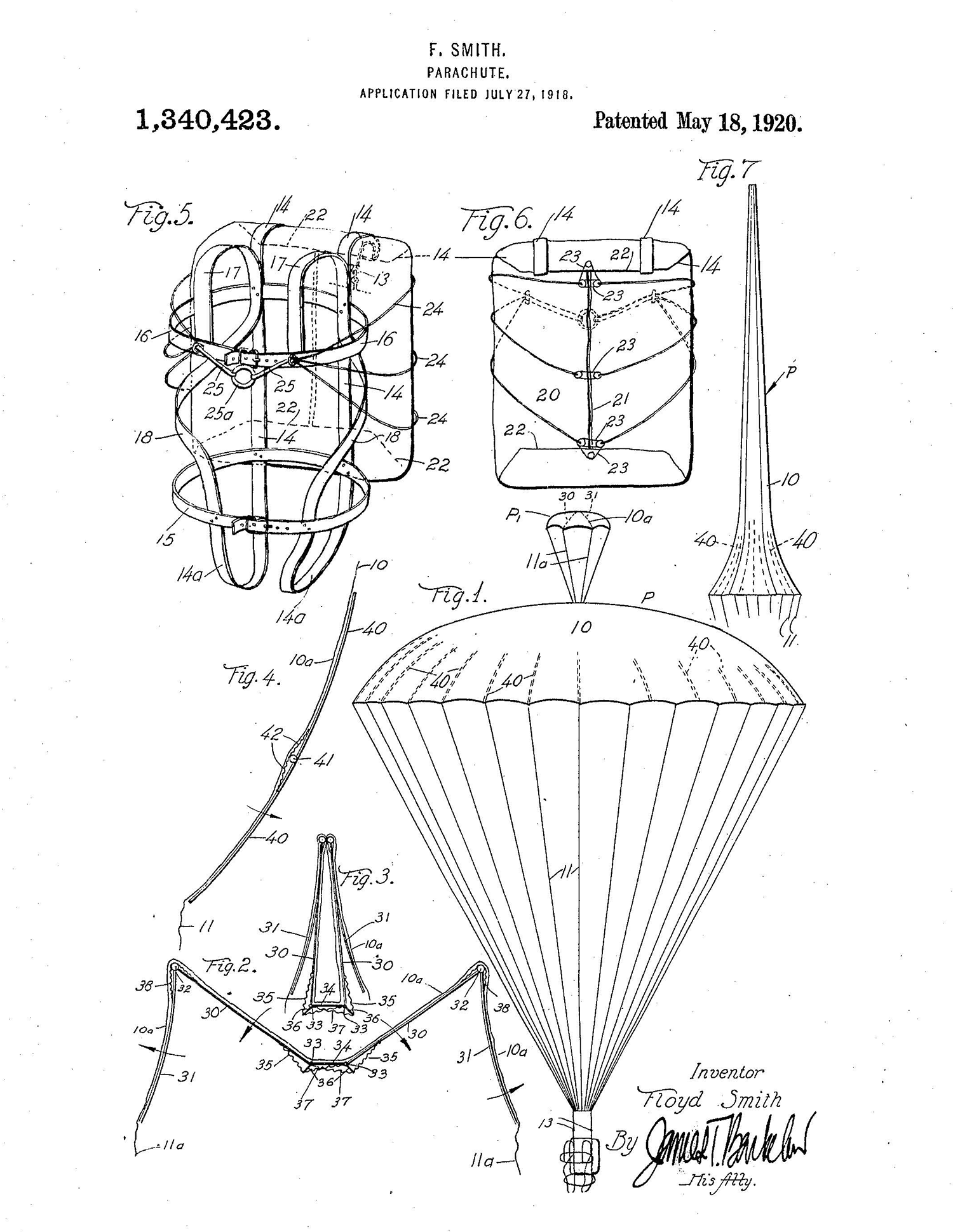
The patent drawings for the Floyd Smith Aerial Life Pack (U.S. Patent No. 1,340,423), the first parachute to rely on a manually operated rip cord.
After Hilder’s near-fatal jump made the issue of safety a personal one, and aware of the military’s increasing use of airplanes, Floyd began to think about ways to improve parachute design. Existing parachutes like Hilder’s, known as the “attached” or “static” type, relied on a pack that was affixed to the plane by a cord or rope that pulled the pack open and released the parachute as the jumper dropped from the plane. As Hilder had inadvertently demonstrated, these parachutes could malfunction if the jump wasn’t completed properly. They could also become tangled if released too close to the plane. They were even more likely to fail if a pilot tried to use one while escaping from a damaged or out-of-control aircraft.
In July 1918, under the name of the newly formed Floyd Smith Aerial Equipment Company, Smith filed a patent application (U.S. Patent No. 1,340,423) for a new type of parachute. Called the “Floyd Smith Aerial Life Pack,” it was the first parachute to rely on a manually operated rip cord. As Smith explained, his parachute “incorporated a method of releasing the chute entirely [from the aircraft], leaving it entirely free in the air stream so that it must blow back and open.” The Life Pack’s design was simple: it consisted of a single piece of waterproof fabric wrapped around a silk parachute and held together by rubber bands that were released when the jumper pulled a rip cord.
Smith’s invention caught the attention of Major E.L. Hoffman, whom the U.S. Army Air Service had charged with forming a parachute research team at McCook Field in Dayton, Ohio, in December 1918, just a month after the armistice ending World War I. Hoffman recruited several civilians to join his team, Smith among them. The group assembled in Dayton in the early spring of 1919. They tested 17 different types of parachutes from around the world, finally settling on a slightly modified version of Smith’s design. After repeatedly testing the parachute using dummies, the team felt ready for a human trial. It was widely believed at the time that a human jumper would become disoriented or even lose consciousness while in free fall and therefore be unable to pull the rip cord. The researchers needed to disprove this theory.

One of the members of Major E.L. Hoffman’s parachute research team makes a test jump at McCook Field in Dayton, Ohio, in May 1919. Image courtesy of the National Museum of the United States Air Force, Wright-Patterson Air Force Base, Ohio.
Smith’s colleague on the research team, Leslie Irvin, already an experienced user of static parachutes, volunteered to make the first jump with the new manually operated design. On April 28, 1919, a crowd, buzzing with a mix of excitement and fear, gathered at McCook Field. Irvin took off in a de Havilland DH9 biplane piloted by Smith. He wore two parachutes—one on his back, which he planned to open first, and one on his chest. Smith leveled off at 1,500 feet and began a straight flight across McCook Field at 100 miles per hour. Irvin then climbed out of the cockpit, smiled and waved at Smith, and jumped. He pulled the rip cord as he fell, and yards of silk billowed out behind him. The parachute fully deployed at 1,000 feet, and Irvin drifted toward the ground under the wide, white canopy. As he landed, his colleagues ran across the field to congratulate him. Smith filed a patent application for the modified parachute design the same day (U.S. Patent No. 1,462,456). It became known as the “Type A” model.
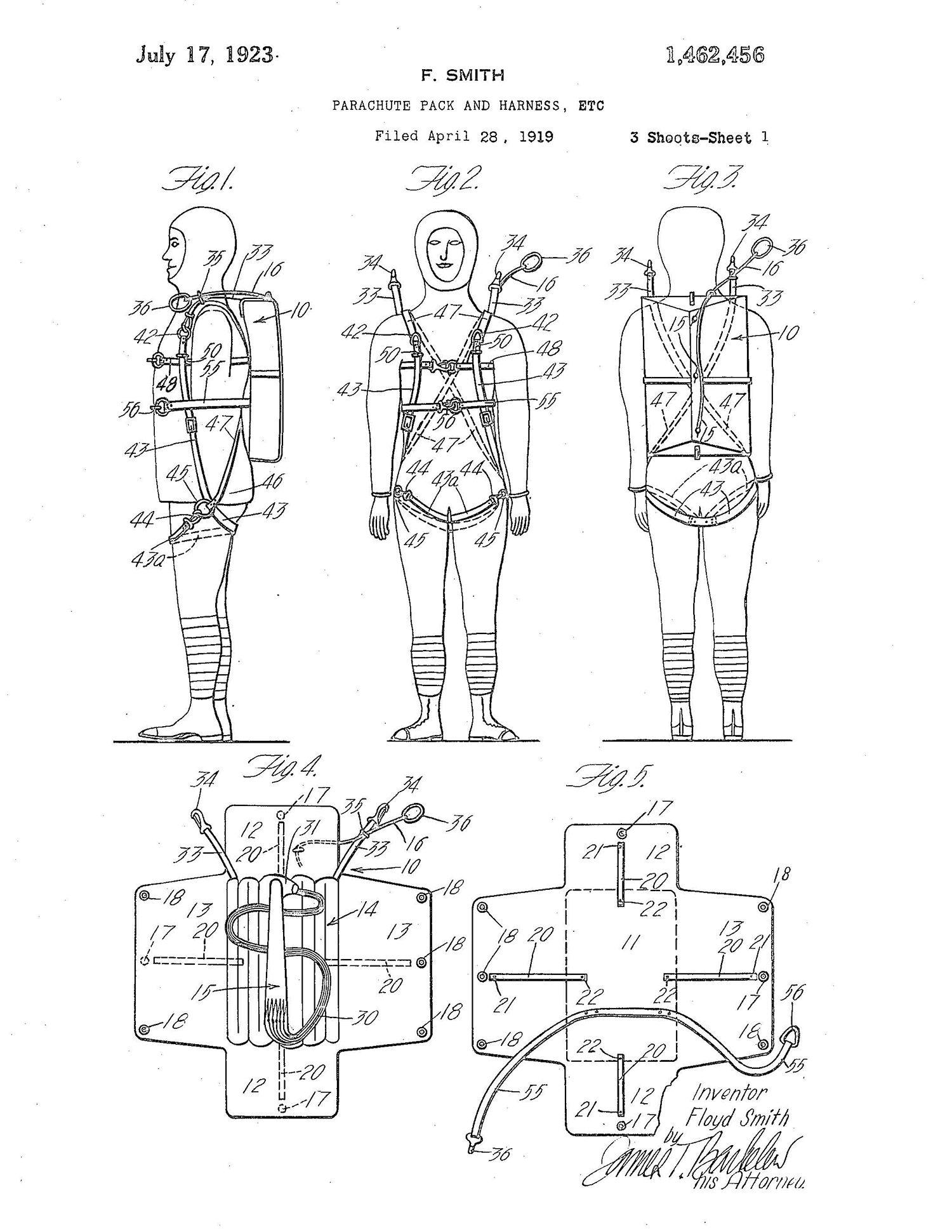
The patent drawings for the ”Type A” parachute (U.S. Patent No. 1,462,456) show three views of a figure wearing the equipment.
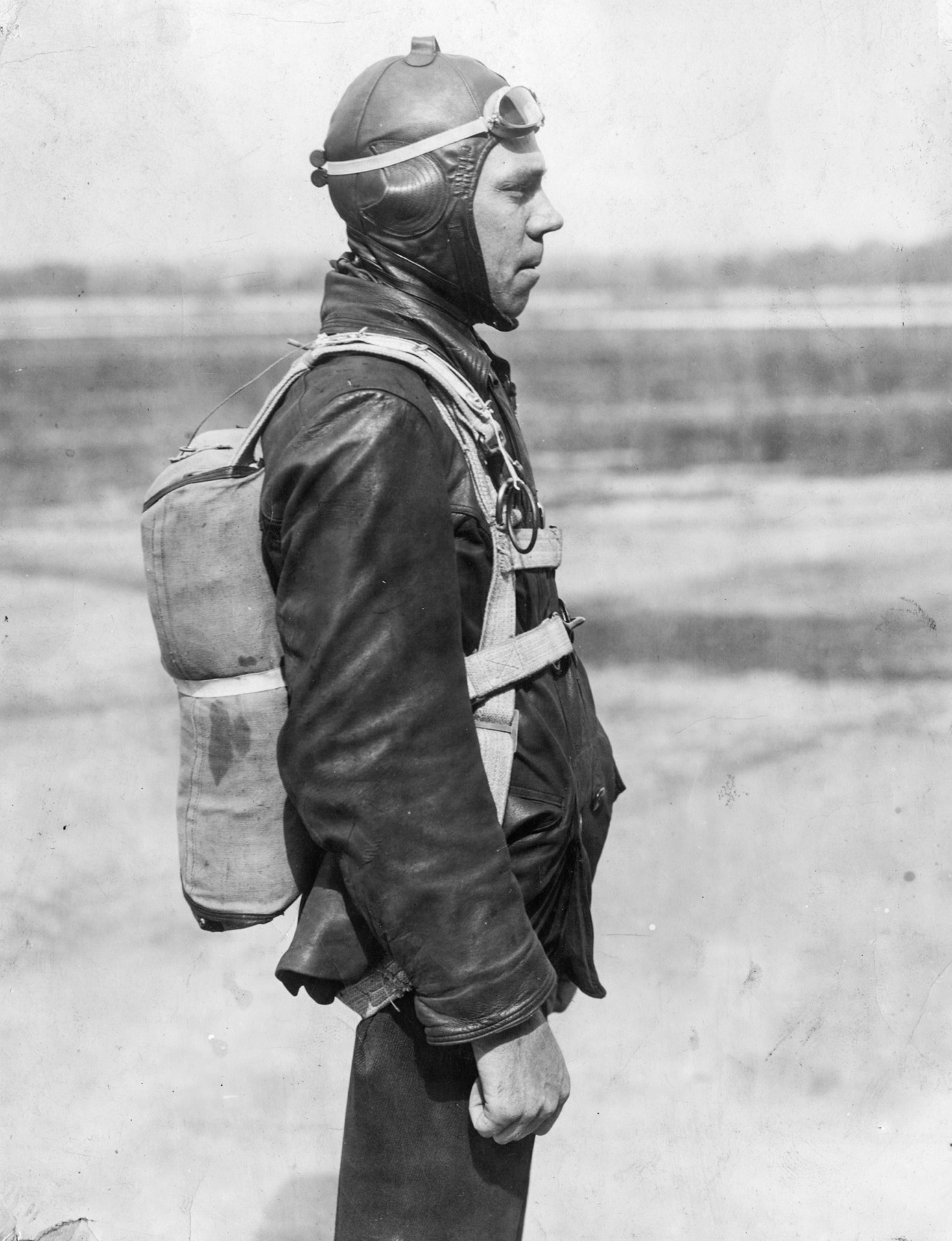
Floyd Smith wears the “Type A” parachute at McCook Field in Dayton, Ohio, in May 1919. Image courtesy of the National Museum of the United States Air Force, Wright-Patterson Air Force Base, Ohio.
Competition to commercially manufacture the parachute was fierce, starting between Smith and Irvin themselves. Less than two months after Irvin’s celebrated jump at McCook Field, he formed the Irving Air Chute Company (a “g” mistakenly added to his last name), together with a silk manufacturer in New York. The U.S. War Department quickly ordered 300 parachutes from Irvin, who had offered the lowest bid for the contract. The Floyd Smith Aerial Equipment Company successfully sued Irvin’s company for infringement, but the judge ruled that although Smith’s patent was valid and Irvin’s company was an infringer, compensation to Smith would be minimal because Irvin’s sales resulted from a U.S. government contract, which protected him from damages. Smith prepared another suit directly against the United States to recover monetary losses, but before filing, the federal government payed him $3,500 for his manufacturing rights. His financial compensation received, Smith assigned the patent to the Irving Air Chute Company, which became one of the main suppliers of parachutes to the U.S. military for many years.
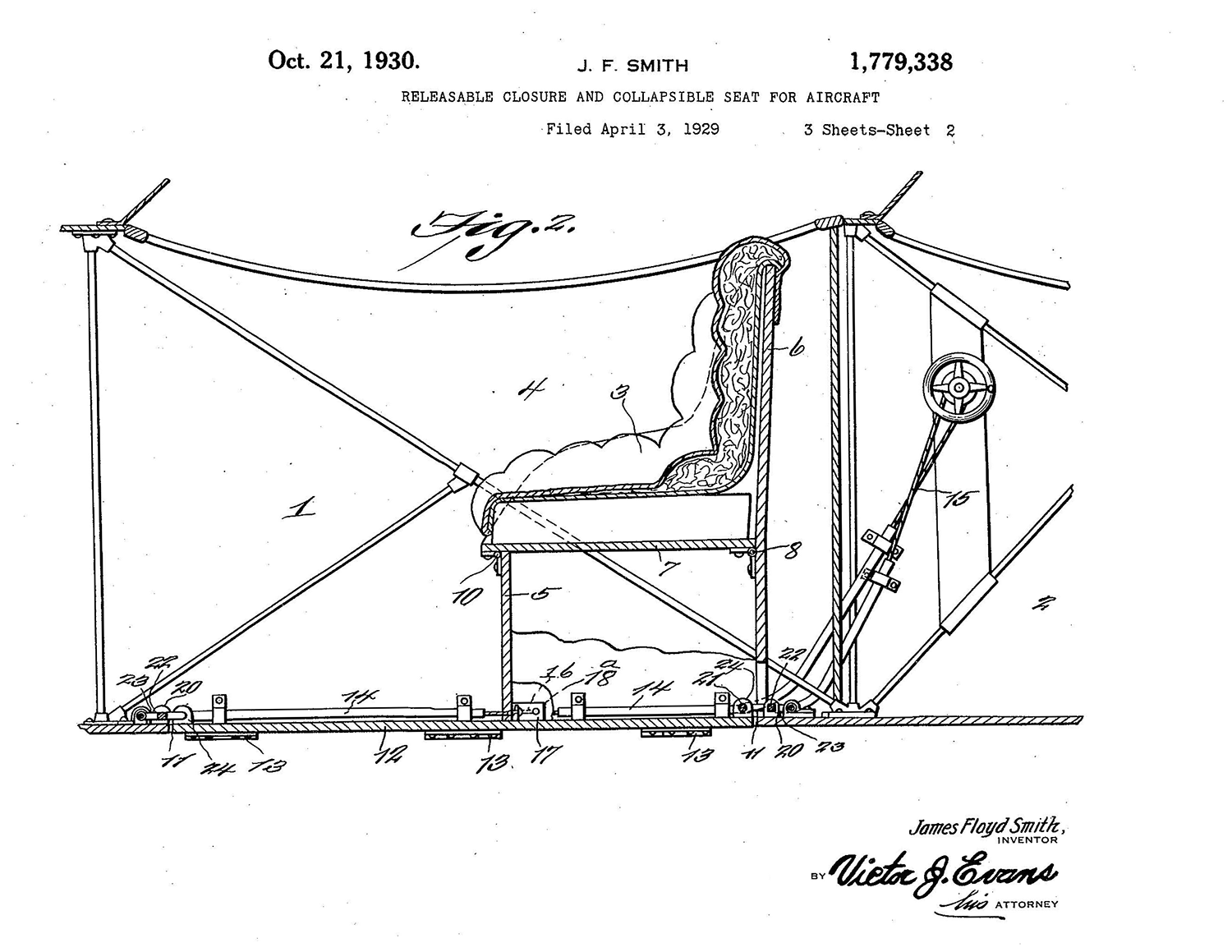
One of the patent drawings for the “Floyd Smith Safety Seat” (U.S. Patent No. 1,779,338) shows the seat positioned above a latched door that could open if a plane experienced an emergency.
Smith continued to develop innovative and creative ideas in support of the rapidly expanding parachute industry. In the mid-1920s, he began to work with Switlik Parachute Company in Trenton, New Jersey. While there, he designed a new rip cord and received a patent on a new type of parachute pack that was easier to use and less expensive to produce (U.S. Patent No. 1,755,414). The company promoted it as the “Floyd Smith Safety Pack.” Smith also invented the “Floyd Smith Safety Seat” for Switlik (U.S. Patent No. 1,779,338). The Safety Seat had an attached parachute and could be dropped through the bottom of an airplane’s fuselage in an emergency.
In 1938, as Europe once again drifted toward war, Smith helped found the Pioneer Parachute Company in Manchester, Connecticut, serving as its vice president and chief engineer. While there, he continued to innovate, making additional improvements to parachute packs and designing new parachutes for pilots (U.S. Patent Nos. 2,316,895, 2,262,119, and 2,316,896, for example). Pioneer was one of the first parachute manufacturers to use nylon instead of silk, which became difficult to obtain during World War II. By 1942, the company was the largest producer of nylon parachutes in the world, and at the height of the war, approximately 3,000 employees worked in continuous shifts to make 300 parachutes each day for the military. Many of the American servicemen who jumped behind enemy lines on D-Day used Pioneer’s parachutes.
Floyd’s son Prevost Smith joined him at Pioneer for several years before the two of them started their own venture, the Smith Parachute Company, in San Diego in 1947. Floyd passed away in 1956, and the company changed its name to the Prevost F. Smith Parachute Company. Like his father, Prevost was a visionary in the world of parachutes. Among his many accomplishments, he was known for designing and manufacturing parachutes for use by astronauts and in drops of military weapons and other equipment, fulfilling contracts with NASA, the Navy, the Air Force, and several large defense contractors.
However, it is Floyd Smith who is remembered as “Mr. Parachute” and one of the pioneers of the parachute industry. Together with his colleagues from McCook Field, Smith changed the world of aviation. Once the military began to buy large quantities of parachutes, companies such as those started by Smith and Irvin met the demand. The military’s confidence in the parachutes led other customers, including the U.S. Air Mail Service and companies in the civilian aviation industry, to place orders. The market continued to evolve and expand throughout the 20th century as innovators created new designs with roots in Smith’s original invention. Thanks in large part to his dedication and creative spirit, aviators ranging from professional pilots to amateur recreational parachute jumpers are now safer in the skies.
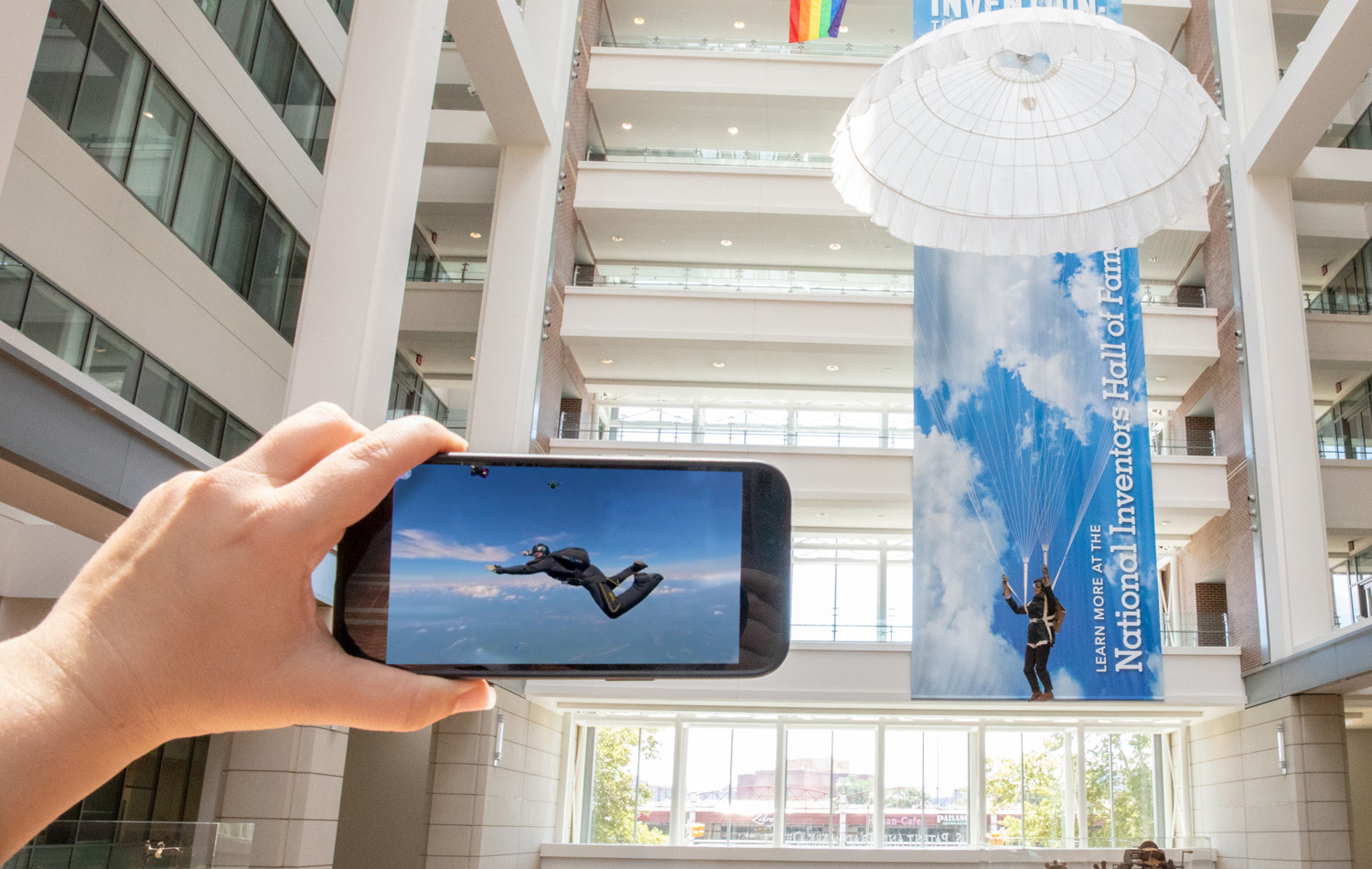
Floyd Smith was inducted into the National Inventors Hall of Fame in 2022, and visitors to the newly reopened National Inventors Hall of Fame and Museum at USPTO headquarters in Alexandria, Virginia can explore special exhibits about Smith and his parachute until Spring 2023, including an interactive parachute jump experience located in the agency's 10-story atrium.
Credits
Produced by the USPTO’s Office of the Chief Communications Officer. For feedback or questions, please contact inventorstories@uspto.gov.
Story by Marie Ladino. Contributions from Andrew Kididis, Eric Atkisson, Lauren Emanuel, and Jay Premack. Photos at the beginning of this story and on the USPTO homepage courtesy of the National Museum of the United States Air Force, Wright-Patterson Air Force Base, Ohio. The homepage image features (left to right) James Russell, Jimmy Higgins, and Floyd Smith.
References
Armstrong-Ingoldsby, Ann, “It All Started in Dayton,” Parachutist, April 1, 2019, https://uspa.org/p/it-all-started-in-dayton.
Dillon, Jane, “Floyd Smith’s Parachute Traceable to Exploits of His Dauntless Wife,” Christian Science Monitor, February 1, 1944, 8.
Heaton, Norman E., “50 Years of Freefall,” Parachutist, April 1, 1969, https://parachutistonline.com/p/Article/50-years-of-freefall-1.
Jackson, Robert, Baling Out: Amazing Dramas of Military Flying (South Yorkshire, England: Pen & Sword Military, 2006), 29-30.
“James Floyd Smith,” Early Aviators, http://www.earlyaviators.com/esmithfl.htm.
Ofgang, Erik, “How a Connecticut Company’s Parachutes Helped Launch D-Day,” Connecticut Magazine, May 22, 2019, https://www.connecticutmag.com/history/how-a-connecticut-company-s-para….
Peck, Wallace R., “San Diego’s Parachute Manufacturers: Visionaries and Entrepreneurs,” Journal of San Diego History 60, no. 3 (Summer 2014): 121-44.
Simkin, John, “Parachutes,” Spartacus Educational, https://spartacus-educational.com/FWWparachutes.htm.
Smith, Floyd, “The Floyd Smith Aerial Life Pack,” Aviation (February 15, 1920): 67-70.
Stamp, Jimmy, “An Early History of the Parachute,” Smithsonian Magazine, March 7, 2013, https://www.smithsonianmag.com/arts-culture/an-early-history-of-the-par….
“Tribute Paid to Floyd Smith, Pioneer Flier,” Los Angeles Times, December 17, 1956, B11.



